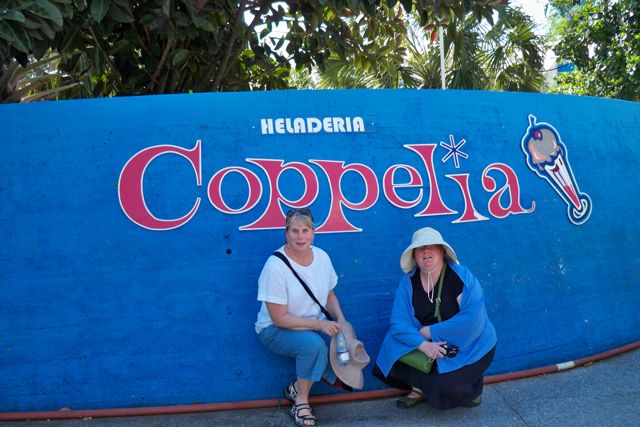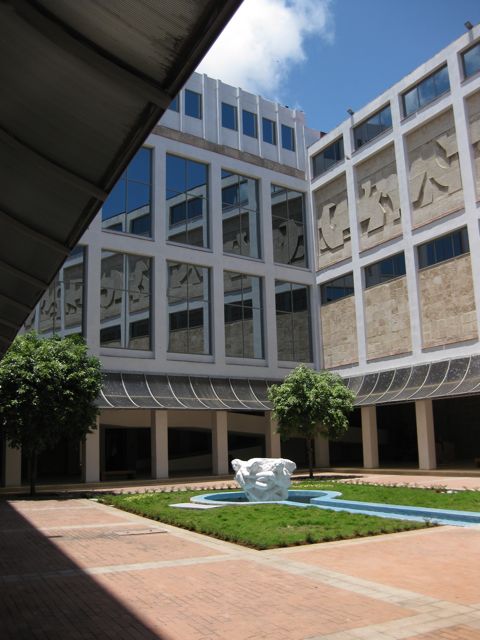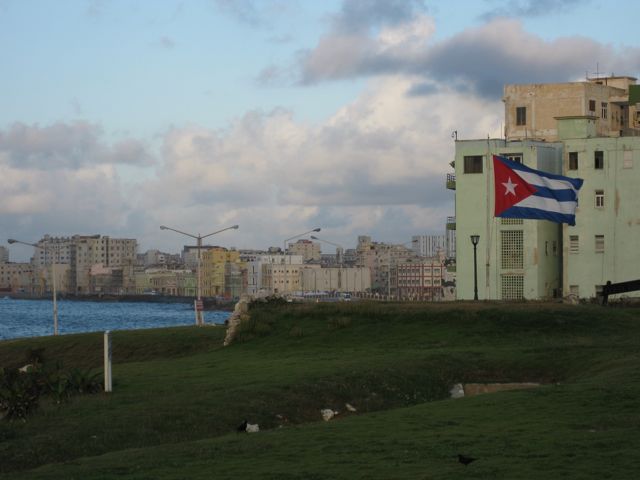Alison
In 1960 Fidel Castro addressed the United Nations and boldly announced his plans to “eradicate illiteracy within six months.” By November 1961, Cuba’s National Literacy Campaign, having sent young and old into adjoining neighborhoods and remote villages, was in full swing. A brilliant strategy that now allows Cuba to claim a 98-99% literacy rate. However, as I consider the following emotional recollection of our 68 year old tour bus driver, I believe the brilliance of this campaign was also in its ability to unify Cubans, promote national pride, and encourage solidarity at a time when the success of the revolution depended on a committed citizenry:
“There are events that transform us as humans…I have had three such
events in my life. One was when I became a father, one was when I
worked in Africa and one was serving as a ‘soldier in Castro’s national
literacy campaign’ (Nafal, 5-18-10).”
Megan
Cuba: A Lesson In Contrasts
Decaying buildings teeming with life
Hot, tight classrooms exuding youthful energy
Many voices with one common message
Ancient autos driven by sixteen year old boys
Hot rice and beans served with cold mojitos
Ration centers nestled next to luxury hotels
CUCs and pesos: two prices, two systems—side-by-side
Proud heroes who are also feared enemies
Hopeful people focused on forgotten causes
Meeting basic needs while beggars still walk the streets
Accordion buses bursting with workers lumbering by tourist buses barely filled
Shared solidarity, but individual lives
Personal aspirations within government control
Arriving in search of answers, but leaving with even more questions
Bill
The revolutionary project lives; neither history nor Fidel, informing everything I have learned here.
The Literacy Campaign changed women. Young, old acknowledge women liberated from homemaking and the people from illiteracy. We met many women community leaders, activists, professionals- important, volunteering, and driving the continuing project.
Stoic Nefal teared-up recalling his Literacy Campaign experiences. Yepe—teen underground revolutionary, friend of Che, protocolist, ambassador. Warm, welcoming, clear. I will write him as this kind of access is so seldom found. He embodies the project.
Cynicism, euphoria, that is the continuing project—recognizing and responding to both. It’s all for the people.
Jim
100 Words for Pork
- Roasted
- Grilled
- Shredded
- Old clothes
- Secret sauce
- Dry
- In soup
- Smoked
- Regurgitated
10. Sliced
11. Gordon bleu
12. Pounded
13. Uruguayan
14. Chunked
15. Brochette
16. Pork chop
17. Suprema
18. Cerdo
19. Ham
20. Wurst
21. Sausage
22. Ham on ham
23. With cheese
24. Cuban sandwich
25. On pizza
26. Chorizo
27. Steam tray pork
28. Fuster pork
29. Lactating pork
30. Pork wontons
31. A side of pork with a pork meal
32. Roasted pork loin
33. More pork?
Heather
Cuba is a country that explodes in color. The flowers and trees have a vivid range of color, as exemplified by the hibiscus, the national flower. The cars, of course, come in every color imaginable, and some never imagined by the original manufacturers. Artists in Cuba capture the brightest colors in their work, and the many of the buildings are brightly painted. Even the people come in a range of colors—from reasonably pale (though one person stopped one of us to say, “You are the whitest person I have ever seen”), to very dark. In terms of color, there is not a Cuban standard look.
While much of the color seems quite haphazard, some is quite ordered. The school children throughout the country, for example, all wear a uniform in the appropriate color for their age. Red with a blue scarf for the youngest, red with red for the older, gold for the high school students, and various shades based on the field for the college students. Blue for the police, and green for the military. Bright yellow spotted ties for the taxi drivers. Black and white for the food service people. You can identify many people at a glance by the color of their clothing.
Even the license plates on the cars are color-coded. Yellow plates are for private cars, blue for state owned, red for rentals (with a plate beginning with “T” for the tourists), white for upper level state officials, orange for foreign workers, and black for the military. All neatly ordered, on the surface.
Joan
FERNANDO * “Would you like to see the most beautiful church in Havana?” * PHOTOGRAPHY * Agua con gas * CUC * Butter rum lifesavers * ENSALADE * Coco Taxi (3x) * PLAYGROUNDS? * Hotel Habana Libre * BARBARA * Mas café por favor * LOGOPEDIA * French fries * ESCUELA * Wooster 9 * IGLESIA * Espresso cups of sweetened coffee * VEGETARIANO * AA batteries * CUCUMBERS * Black Beans * RICE * Taxi? No gracias * Rash girl * Mojito? No gracias * “Lady, open your bag.” * Quanto cuesta? * Muy cocidas * HUEVOS * “Hello lady!” * SPAGHETTI * Beth’s notebooks * PIZZA * Habla Ingles? * PINEAPPLE * Ice cream with fruit * NAFAL * “You are very white.” * RITA * TATIANNA * Literacy museum * FRIENDLY * The man in the pink shirt * José Marti * CCTV in English * HOT * HUMID * Change your batteries * CATS * DOGS * Switchy doll * SILENCIO * “You like my country?” * BENADRYL * “We share what we have.” * HOUSING * “There are things that transform you as a human being.” * SOLIDARITY * REVOLUTION * AA batteries * BLOCKADE *
Beth
Things I learned in Cuba:
• The Palm Tree, though not indigenous, is the national tree of Cuba.
• Private, collective and state farms exist; private farms yield more produce in general and the produce is more diverse.
• The first railroad of the Americas was built in Cuba in the 1830s.
• Cuba’s national hero is José Martí, a poet, an essayist, an activist. He is quoted everywhere and his bust is to be found EVERYWHERE. After a visit to Cuba, if you do not know Martí, you have not seen Cuba.
• Next to Martí, the three most commonly found heros respresented on posters and signs are Che Guevera, Mella, Camillo Cien Fuegos.
• The only advertising you see is in defense of the revolution (todo por la revolution).
• Images of Rual and Fidel Castro are not found, according to Fidel’s anti-cult of personality.
• You can hear roosters crow every morning from the 20th floor of the Habana Libre Hotel (formerly the Cuban Hilton).
• You cannot wander freely as a visitor on the University of Havana campus.
• Fernando Ortiz, a sociologist, came up with the idea of transculturation, in which we adopt aspects of foreign cultures we encounter into our own (colonialism isn’t a one-way street).
• We have decided to adopt Mojitos, the collective, and rumba into Wooster faculty meetings.
• Cuban cigars are very smooth. The rum is too. Coffee too. Coffee and rum even better.
• “There is no sugar cane production.” The Ministry of Sugar is just down the street from our hotel.
• “There is no poverty and the aging population is given great attention.”
• Of the few beggars we saw in Old Havana, most were elderly folks.
• The concept of becoming a medical doctor in order to earn a high salary is completely foreign.
• Goats can be found grazing on the former military airport grounds and run-way.
• Cubans walk and hitchhike on the highway.
• You can flag down any vehicle with government plates and ask for a ride.
• Former military barracks and grounds have been converted to primary schools (true to Fidel’s mandate).
• All Cubans have a ration card to get their groceries, so they are never without the basics.
• You must love rice, black beans and pork to survive here.
• The symbol of the Federation of Cuban Woman is a woman holding a machine gun.
• Illegal drug use stems from different substances “washed up on Cuban shores from passing boats.”
• The number one problem facing Cuba (aside from issues of the blockade), is housing.
• We can all do a mean rumba when encouraged properly, out of the public eye, and on top of a rooftop in Old Havana (i.e. location is everything).
Matthew
What stands out for me as we leave Cuba are the purposeful steps towards progressive educational practices that appear to be country-wide. Though I am not a huge fan of the standardized educational movement (even in the U.S.), I am amazed at the Cubans’ efforts to provide quality instruction regardless of location. One example of this practice is their use of a low-tech “distance learning” methodologies via T.V. and VCR. Across the country, students are exposed to the same researched and vetted teaching strategies; from inner city Havana to distant rural villages, the quality of the instruction is not just consistent, but the same. While this method may not be fostering the 21st Century skills we hold so dear in the U.S., it does make the Cuban people poised and ready for when more technologically advanced modes of distance learning become available. The process is in place; they are just waiting on the technology to help take them further.







